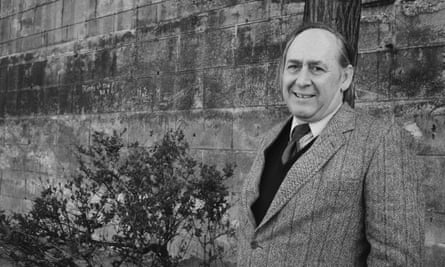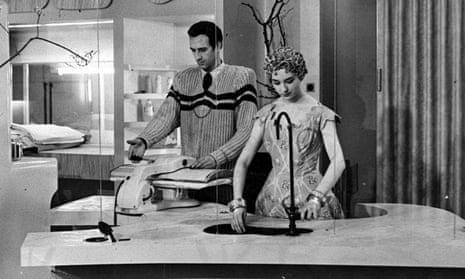From the red-brick flats on the windswept estate where I grew up to the concrete skyscrapers clustered in the town centre, Croydon loves ripping it up and starting again. The relics of waves of modernisation are everywhere, and they’re why I set out to write Concretopia, and tell the story of the postwar rebuilding of Britain. I wanted to understand how this had happened to my home town, and others like it, and what it must have been like between the 1940s and the 1970s when a pioneering spirit ruled.
I travelled from Plymouth to Cumbernauld talking to people who’d lived and worked in these new towns, high-rises and streets in the sky, and the architects and planners who’d created them. And I read. A lot. Heavily foxed town plans from the forties, biographies, social histories, newspaper articles, diaries…
For this top 10 I’ve picked out my favourite – and most colourful – modernisers’ tales: half are novels, half biographies. Several are upbeat, many are critical, and across them they give a flavour of what the modern movement in architecture and planning was up to, particularly in postwar Britain.
Her Brilliant Career: Ten Extraordinary Women of the Fifties by Rachel Cooke (2013)
Who’s afraid of Alison Smithson? Well, I was, until I read this. Smithson – architect, fashion icon and legendarily terrible novelist – shares the book with nine other remarkable women, and Rachel Cooke succeeds in bringing her to life with great wit and compassion. She, along with her husband Peter, introduced Britain to brutalism with their 1940s secondary modern school in Hunstanton, after which they spent most of their lives struggling to get much built at all. Cooke plays off the intimate details of their lives against their grand plans, and it left me feeling such warmth and admiration for the awkward duo, in their uncompromisingly modern life.
Our Fathers by Andrew O’Hagan (1999)
Glasgow city father Hugh Bawn is dying, and his grandson, Jamie, plans to demolish the Gorbals tower blocks Hugh had championed in the 60s. Shortlisted for the Booker back in 1999, this is a moving novel weighed down with lost hopes. Hugh, the unrepentant moderniser, is a brilliant creation, calling to mind Newcastle’s notoriously corrupt fixer T Dan Smith, on whom characters in both Our Friends in the North and David Peace’s Red Riding quartet have been based.
Big Jim: The Life and Work of James Stirling by Mark Girouard (1998)
The egotist’s egotist, James Stirling achieved fame with university buildings such as the history faculty library in Cambridge. Girouard’s witty, colourful biography perfectly captures the man and his world, and gives a great inside view of the politics, passions and conflicts of a whole stratum of Britain’s modern artists and architects.
The Glass Room by Simon Mawer (2009)
The elegant glass room of the novel’s title is heavily based on Mies van der Rohe’s 1920s Villa Tugendhat in Brno. Mies’s fictional counterpart is Rainer von Abt, and the house he designs remains the central conceit of the book, from where we move from bourgeois high living to Nazi invasion and beyond. Mawer fuses big history with domestic drama in a Booker-shortlisted novel that sometimes lacks the lightness of the building.
The Power Broker: Robert Moses and the Fall of New York by Robert A Caro (1974)
Robert Moses planned much of New York from the 1920s to the 60s. His epic J Edgar Hoover-like tenure was chronicled – and shredded – in this suitably colossal book. Tales of racism and dirty dealing are entwined with an enormous legacy of expressways and housing. From the era of All The President’s Men, Caro’s investigative storytelling is gripping throughout – and at over 1,000 pages, it needs to be.
The News Where You Are by Catherine O’Flynn (2010)
A local news presenter takes photos of a soon-to-be-demolished Birmingham skyscraper, explaining to his young daughter that her grandfather designed it. Thus opens O’Flynn’s novel, whose late architect is based on John Madin, mastermind of much of postwar Birmingham, including the splendid – and sadly doomed – brutalist Central Library. This is a quirky portrait of a city caught up in permanent revolution.
Ernö Goldfinger: The Life of an Architect by Nigel Warburton (2003)
The looming figure of Ernö Goldfinger deserved a hard-hitting biography, and Warburton provides just that. Goldfinger is best known for Balfron and Trellick Towers, and for getting up the nose of the equally unpleasant Ian Fleming. This book records the development of an amazing architectural vision, but is full of uncomfortable truths about the man – random sackings, bullying and the pawing of women.

High Rise by JG Ballard (1975)
It’s Lord of the Flies in a tower block. This novel, in which the wealthy residents of a luxurious Barbican-like tower descend into savagery, has haunted me since I first read it as a teenager. I think of it as the fatalistic second act to Ayn Rand’s bombastic The Fountainhead. Anthony Royal, the arrogant architect, lives in the block, just as Ernö Goldfinger had in Balfron Tower. Incidentally, Ballard was hugely influenced by the Smithsons’ post-apocalyptic house exhibited in the 1956 Whitechapel Gallery art show This is Tomorrow.
Read JG Ballard on modernists and death
Modern Architect: the Life and Times of Robert Matthew by Miles Glendinning (2008)
Robert Matthew packed a lot in. He co-wrote the postwar plan to rebuild Glasgow, headed the enormous London County Council architects’ department, co-designed the Festival Hall and some of the Gorbals’ only remaining high-rise blocks, then joined the “preservationists” and saved Edinburgh’s Georgian New Town. Glendinning’s biography follows this most remarkable man through his Zelig-like life, in the most inspiring and uplifting of the biographies here.
Late Call by Angus Wilson (1964)
My final modernisers are not architects or planners, but rather the people who moved into the new world that had been built, and tried to modernise their lives accordingly. In Angus Wilson’s marvellous novel Late Call, recently widowed Harold embraces modern architecture and go-ahead new town life, but it’s a challenge to his parents, who miss the comforts of their former, almost Edwardian, lifestyle. Waspish, clever and full of unexpected twists, this is a book for anyone wanting the everyday oddity of this post-war moment, with its dreams, snobberies and culture clashes, brought vividly to life.

Comments (…)
Sign in or create your Guardian account to join the discussion